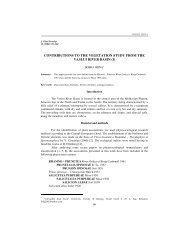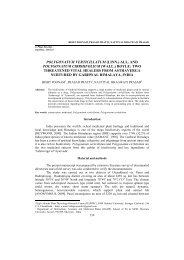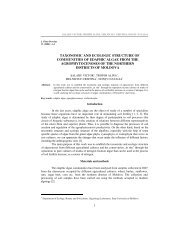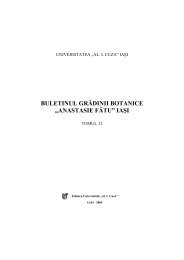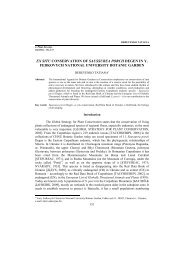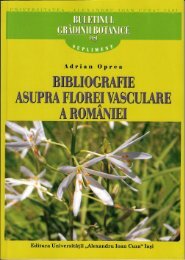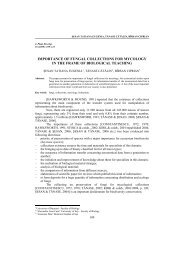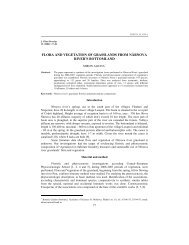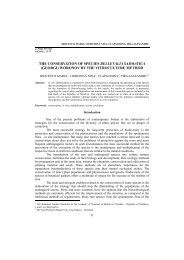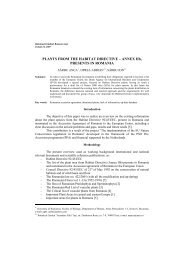the moldova vegetation exposition from - Journal of Plant ...
the moldova vegetation exposition from - Journal of Plant ...
the moldova vegetation exposition from - Journal of Plant ...
Create successful ePaper yourself
Turn your PDF publications into a flip-book with our unique Google optimized e-Paper software.
122<br />
It was conceive to establish main forest types such as: beech forests (Fagus<br />
sylvatica), sessile oak forests (Quercus petraea), pedunculate oak forests (Quercus robur),<br />
pubescent oak forests (Quercus pubescens), white poplar forests (Populus alba) and willow<br />
forests (Salix alba, Salix fragilis).<br />
The trees and shrubs have been planted irregularly but with <strong>the</strong> endeavor that <strong>the</strong><br />
composition would be more close to <strong>the</strong> structure <strong>of</strong> natural forests. Trees and shrubs have<br />
been transported <strong>from</strong> each type <strong>of</strong> natural forests and were planted in each type <strong>of</strong> micro<strong>exposition</strong>.<br />
The grass layer has been made by transplanting furrows with grass layers<br />
(30x30 cm) brought <strong>from</strong> natural forests that have been placed in micro-<strong>exposition</strong>s.<br />
Cleaning and conservation cuttings have been carried out each five years.<br />
The steppe micro-<strong>exposition</strong> has been created by using next two methods: <strong>the</strong><br />
method <strong>of</strong> furrows with grass layer and <strong>the</strong> second method by sowing seeds previously<br />
collected. The seeds <strong>of</strong> next species have been collected (Stipa capilata, S lesingiana,S.<br />
pulcherima, Festuca valesiaca etc.) <strong>from</strong> <strong>the</strong> Bujac steppe. These methods have been also<br />
used to realize areas with grass <strong>vegetation</strong> in St.Petesburg (Tanfiliev,1901), Moscow<br />
(Sorokina, 1960), Stavropol (Skripcinski, 1973; Dudari,1977; Dzăbov 1977), Doneţk<br />
(Ziman, Ivaşin,Ciuprina,1975), Chişinău (Postolache, 1984,2004). Works <strong>of</strong> creation <strong>the</strong><br />
Moldova Vegetation Exposition commence in 1972 and continue in present time.<br />
Results and discussions<br />
Moldova forests and establishment <strong>of</strong> forests micro-<strong>exposition</strong>s<br />
The spontaneous forests in Moldova consist <strong>of</strong> broadleaved formations <strong>of</strong> Central<br />
Europe type. The main components in <strong>the</strong> forest formations are <strong>the</strong> pedunculate oak<br />
(Quercus robur), <strong>the</strong> sessile oak (Quercus petraea), <strong>the</strong> pubescent oak (Quercus pubescens)<br />
and <strong>the</strong> beech (Fagus sylvatica). Their spread on <strong>the</strong> territory <strong>of</strong> <strong>the</strong> Republic <strong>of</strong> Moldova<br />
depends on <strong>the</strong> hypsometric levels, on <strong>the</strong> <strong>exposition</strong> and <strong>the</strong> degree <strong>of</strong> slope inclination, on<br />
<strong>the</strong> soil and o<strong>the</strong>r conditions [1, 2, 3]. These and o<strong>the</strong>r factors determined <strong>the</strong> formation <strong>of</strong><br />
different types <strong>of</strong> forests and associations.<br />
The pedunculate oak is <strong>the</strong> principal species in <strong>the</strong> forest stands <strong>from</strong> <strong>the</strong> nor<strong>the</strong>rn<br />
zone. Ninety percent <strong>of</strong> natural forests in <strong>the</strong> nor<strong>the</strong>rn part <strong>of</strong> Moldova belong to <strong>the</strong> forest<br />
type “forest oak with cherry” (Prunus avium).<br />
The Central Zone <strong>of</strong> <strong>the</strong> Republic <strong>of</strong> Moldova is a more compact forest massif and<br />
is comparable to <strong>the</strong> broadleaf forest <strong>of</strong> <strong>the</strong> central zone <strong>of</strong> Europe. The dominant tree<br />
species are Fagus sylvatica, Quercus petraea and Quercus robur. The favourable<br />
ecological conditions lead to <strong>the</strong> formation <strong>of</strong> highly productive forest stands. Hornbeam<br />
(Carpinus betulus) is abundant in forest stands.<br />
The Sou<strong>the</strong>rn Zone is <strong>the</strong> driest, and is characterized by oak at <strong>the</strong> higher<br />
elevations and by pedunculate oak mixed with blackthorn at lower elevations. Fluffy oak<br />
forests (Quercus pubescens) are found on south and south-western slopes at lower<br />
elevations.<br />
The territory <strong>of</strong> <strong>the</strong> Botanical Garden allocated for <strong>the</strong> establishment <strong>of</strong> <strong>the</strong><br />
Moldova Vegetation Exposition includes plateau and hills with different <strong>exposition</strong>s,<br />
variety <strong>of</strong> soil types and hydrological conditions. The presence <strong>of</strong> a variety <strong>of</strong> conditions at<br />
<strong>the</strong> Botanical Garden permitted establishment <strong>of</strong> major types <strong>of</strong> forests that have been<br />
carried out by taking into considerations local conditions.



